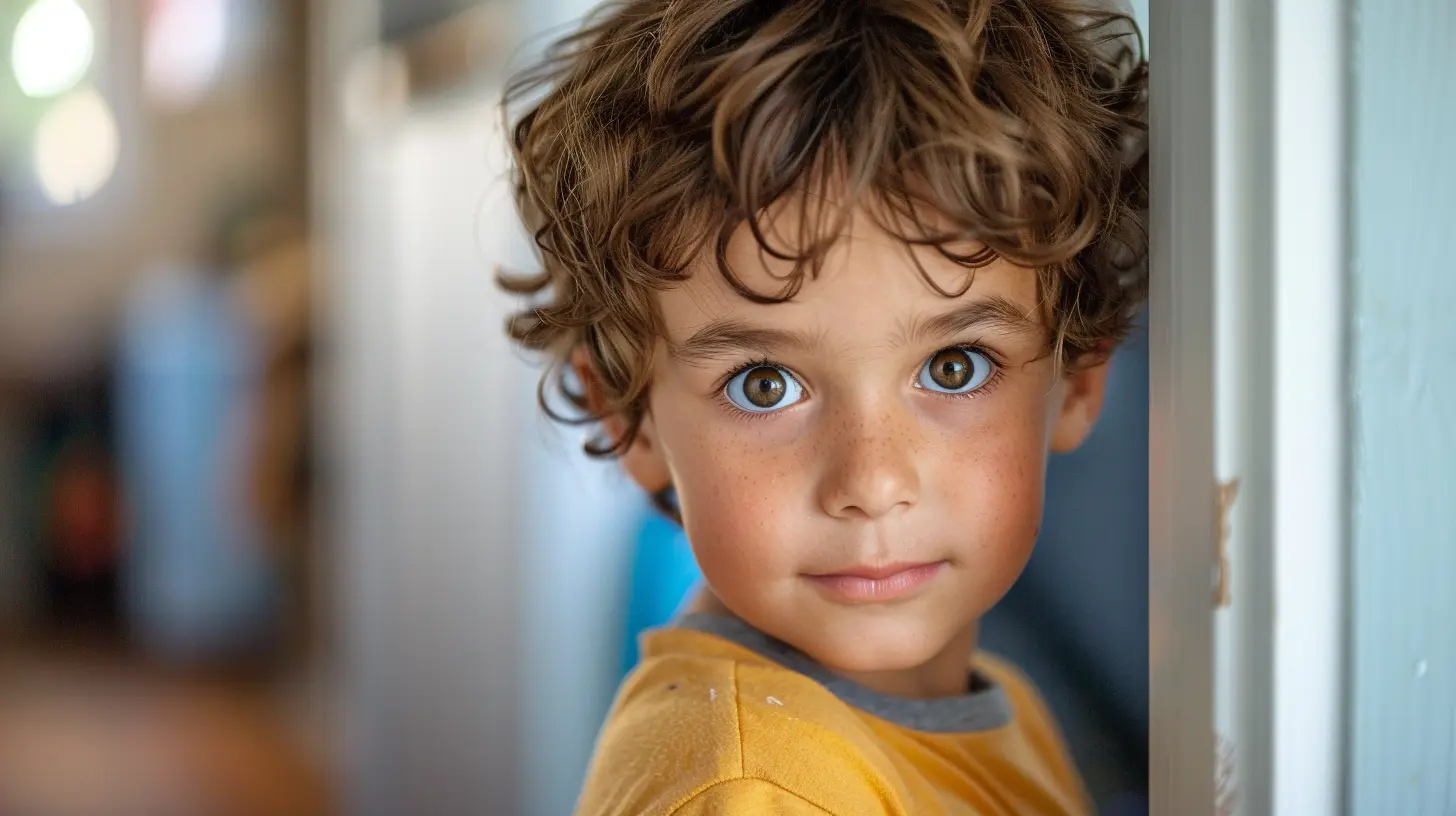Teaching ‘Personal Space’: Why Physical Boundaries Are Important
11 July 2025
Let’s face it—kids can be touchy-feely. Whether it's hugging every friend they meet or standing a little too close during conversations, young children are still learning the dos and don’ts of social interaction. As parents, we often focus on teaching manners like saying “please” and “thank you,” but there’s one lesson that doesn’t always get the spotlight it deserves: teaching personal space.
Sounds simple, right? But the concept of physical boundaries is more complex than you might think. And honestly, it’s one of those life skills that pays off big time—emotionally, socially, and even physically—for everyone involved. In this post, we’re diving deep into why teaching your child about personal space isn’t just important... it’s essential.
What Is Personal Space, Anyway?
Imagine standing in line at the grocery store and someone behind you is breathing down your neck. Uh, hello? Ever felt that cringe-worthy tension? That’s your personal space being invaded—and it doesn’t feel good.Personal space is the invisible bubble we keep around us to feel comfortable and safe. It varies depending on culture, situation, and relationship. With our partner? Close is cozy. With a stranger? Back it up, buddy.
For kids, this concept doesn’t always come naturally. They’re still learning social cues and emotional intelligence. But here’s the good news: with a little guidance, they can totally get it.
Why Is Teaching Personal Space So Important?
1. It Keeps Everyone Comfortable
Think back to when your toddler first started playing with others. Remember those moments when they got a little too handsy? Maybe they climbed into another kid’s lap or reached out to grab a toy someone else was holding. Cute? Sure, in the beginning. But as they grow, these behaviors need some refining.Teaching kids about physical boundaries helps them respect others’ comfort zones—and protects their own. It builds mutual understanding and emotional safety in relationships.
2. It Helps Prevent Bullying and Aggression
Here’s something you might not have considered: a lack of understanding about personal space can actually lead to conflict. When kids don’t grasp the importance of boundaries, they might push, shove, or invade someone’s space unintentionally. Other children may interpret this as aggression, and boom—trouble brews.By teaching your child about space and consent, you’re setting up a foundation for non-violent conflict resolution and empathy. That, my friend, is a parenting win.
3. It Builds Self-Respect and Confidence
When kids learn they are allowed to say “no” to unwanted touch or closeness, they start to develop a healthy sense of bodily autonomy. They begin to understand that THEIR space matters too—and that’s empowering.This isn’t just about preventing others from crossing a line—it’s also about allowing your child to feel safe standing up for themselves.
When Should You Start Teaching It?
The earlier, the better. Seriously.Even toddlers can begin to grasp the idea that “this is my body,” and “we ask before touching.” You don’t have to wait until your child goes to school to start these conversations. In fact, incorporating this awareness into your daily routines when your child is still young will make it feel natural and intuitive later on.
How to Teach Personal Space in a Kid-Friendly Way
Alright, let’s get into the nitty-gritty. How do you actually teach this boundary stuff without sounding like a robot or making it super awkward?1. Use Visuals and Analogies
Kids are visual learners. One great method is using the "personal space bubble” analogy. Tell your little one that everyone has an invisible bubble around them—kind of like a superhero force field. You can even physically demonstrate it using arm’s length as a guide.Draw it out, act it out, or use toys to model different scenarios. The more relatable, the better.
2. Practice with Role-Playing
Make it playful! Role-playing is a fantastic way to teach social skills. Pretend you're at a party or the park. One of you is the person who stands too close. The other is the one protecting their space. Switch roles and talk about how it feels.Ask questions like:
- “How does your body feel when someone gets too close?”
- “What can you say if you need more space?”
This helps build emotional vocabulary as well as situational awareness.
3. Model It Yourself
Let’s be honest—kids are little sponges. They’re watching you, even when you think they're not.Respect their space. Ask before hugging them. Knock before entering their room. Show them it's okay to say, "Not right now" or "I need some space." When you do this, you’re not just teaching them—you’re showing them.
Remember, what you do teaches just as much (if not more) than what you say.
4. Use Books and Stories
Storytime is powerful. There are tons of great children’s books that touch on personal space and boundaries. These stories often deliver lessons in a way that’s easier for kids to understand and apply.A few favorites include:
- “Personal Space Camp” by Julia Cook
- “Miles is the Boss of His Body” by Samantha Kurtzman-Counter & Abbie Schiller
- “Don’t Hug Doug (He Doesn’t Like It)” by Carrie Finison
Read along and chat about the characters’ choices. What did they do right? What could they have done differently?
5. Teach About Consent Early and Often
Consent isn’t just for grown-ups. Kids need to understand that it’s okay to say “no” and that it’s just as important to hear and accept “no” from someone else.Whether it’s tickling, hugging, or sharing toys—always emphasize the importance of asking first. Phrases like:
- “Is it okay if I give you a hug?”
- “Would you like to sit next to me?”
- “Do you feel comfortable with that?”
These are simple but powerful ways to plant the seed of consent.
What to Do When Boundaries Get Crossed
Spoiler alert: your kid is going to mess up sometimes. That’s all part of learning.Instead of shaming or punishing, use it as a teachable moment. If your child stands too close to a stranger or grabs a toy out of another child's hands, gently pause the situation. Ask them, "How do you think that made the other person feel?" Then guide them toward a better way to handle it next time.
Reinforce the idea that mistakes are okay—as long as we own them and learn from them.
Teaching Kids to Respect Others and Themselves
The beauty of teaching personal space is that it goes both ways. You’re not just helping your child respect others—you’re also giving them permission to draw their own boundaries. And that skill? It's pure gold, especially as they grow into teens and adults.When your child knows they can say, “I don’t like that,” they’re more likely to speak up in uncomfortable situations. This can be a huge protective factor against peer pressure, bullying, and even abuse.
Respecting Different Comfort Zones
Personal space isn’t one-size-fits-all. Some people are huggers. Others? Not so much.Your child might be super affectionate, while their cousin might shy away from touch altogether. That’s okay!
It’s important for kids to understand that everyone has different comfort levels—what feels fine to one person might feel invasive to another. Teach them to read body language, make eye contact, and ask before acting.
This approach builds empathy and emotional intelligence—two super important life skills.
Keep the Conversation Going
Teaching personal space isn’t a one-and-done type of lesson. It’s something that evolves as your child grows, encounters new social situations, and interacts with all kinds of people.Make it a regular topic in your home. Ask about how they felt during different interactions throughout their day. Were there moments when they wished they had more space? Less? Did they notice how others reacted to their presence?
Keep the chat casual and open-ended. No pressure, no lectures—just conversation.
Final Thoughts
At the heart of it, teaching personal space is about respect—respect for others and respect for ourselves. And that’s something every child deserves to understand.Sure, there may be some awkward moments and a few lessons learned the hard way (cue the embarrassed parent face at the crowded birthday party), but it’s all worth it.
So start early, make it fun, and be patient. Before you know it, your child will be more in tune with the invisible bubbles all around them—and better equipped to navigate the world with kindness, confidence, and care.
all images in this post were generated using AI tools
Category:
Parenting BoundariesAuthor:

Noah Sawyer
Discussion
rate this article
2 comments
Monica McCray
This article beautifully highlights the importance of teaching children about personal space, fostering respect and understanding in their interactions with others.
November 18, 2025 at 3:42 AM

Noah Sawyer
Thank you! I'm glad you found it valuable—teaching personal space is indeed crucial for building respectful relationships.
Rosalie Williams
Empowering our children to understand and respect personal space cultivates confidence and healthy relationships. Let's nurture their ability to set and honor boundaries for a brighter future!
July 24, 2025 at 3:27 PM

Noah Sawyer
Thank you for your insightful comment! Encouraging children to understand and respect personal space is indeed essential for fostering confidence and healthy relationships.


